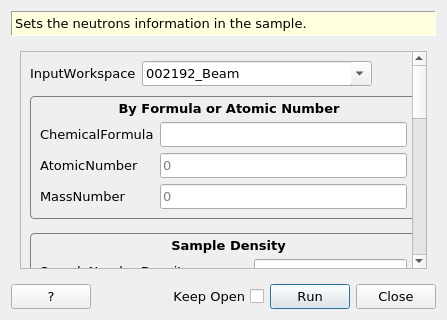\(\renewcommand\AA{\unicode{x212B}}\)
SetSampleMaterial v1¶

SetSampleMaterial dialog.¶
Summary¶
Sets the neutrons information in the sample.
See Also¶
SetSample, AbsorptionCorrection, CreateSampleShape, CalculateSampleTransmission
Properties¶
Name |
Direction |
Type |
Default |
Description |
|---|---|---|---|---|
InputWorkspace |
InOut |
Mandatory |
The workspace with which to associate the sample |
|
ChemicalFormula |
Input |
string |
The chemical formula, see examples in documentation |
|
AtomicNumber |
Input |
number |
0 |
The atomic number |
MassNumber |
Input |
number |
0 |
Mass number if ion (use 0 for default mass number) |
SampleNumberDensity |
Input |
number |
Optional |
This number density of the sample in number of atoms or formula units per cubic Angstrom will be used instead of calculated |
SampleEffectiveNumberDensity |
Input |
number |
Optional |
Defines the effective number density of the sample, which is related to the number density and packing fraction. |
SamplePackingFraction |
Input |
number |
Optional |
Defines the packing fraction of the sample which can be used to calculate the number density and the effective number density |
ZParameter |
Input |
number |
Optional |
Number of formula units in unit cell |
UnitCellVolume |
Input |
number |
Optional |
Unit cell volume in Angstoms^3. Will be calculated from the OrientedLattice if not supplied. |
CoherentXSection |
Input |
number |
Optional |
This coherent cross-section for the sample material in barns will be used instead of tabulated |
IncoherentXSection |
Input |
number |
Optional |
This incoherent cross-section for the sample material in barns will be used instead of tabulated |
AttenuationXSection |
Input |
number |
Optional |
This absorption cross-section for the sample material in barns will be used instead of tabulated |
ScatteringXSection |
Input |
number |
Optional |
Optional: This total scattering cross-section (coherent + incoherent) for the sample material in barns will be used instead of tabulated |
AttenuationProfile |
Input |
string |
The path name of the file containing the attenuation profile. Allowed extensions: [‘.dat’] |
|
XRayAttenuationProfile |
Input |
string |
The path name of the file containing the Xray attenuation profile. Allowed extensions: [‘.dat’] |
|
SampleMassDensity |
Input |
number |
Optional |
Measured mass density in g/cubic cm of the sample to be used to calculate the effective number density. |
SampleMass |
Input |
number |
Optional |
Measured mass in g of the sample. This is used with the SampleVolume to calculate the number density. |
SampleVolume |
Input |
number |
Optional |
Measured volume in gm^3 of the sample. This is used with the SampleMass to calculate the number density. |
NumberDensityUnit |
Input |
string |
Atoms |
Choose which units SampleNumberDensity referes to. Allowed values: [‘Atoms’, ‘Formula Units’] |
Description¶
Sets the neutrons information in the sample. You can either enter details about the chemical formula or atomic number, or you can provide specific values for the attenuation and scattering cross sections and the sample number density. If you provide a chemical formula or atomic number, the cross sections will be calculated from a database. If you decide to provide specific cross sections, they will override the tabulated ones. For details of how the various quantities are calculated, refer to the Materials concept page.
Note
It is recommended that you use SetSample instead.
Categories: AlgorithmIndex | Sample
Source¶
C++ header: SetSampleMaterial.h
C++ source: SetSampleMaterial.cpp
